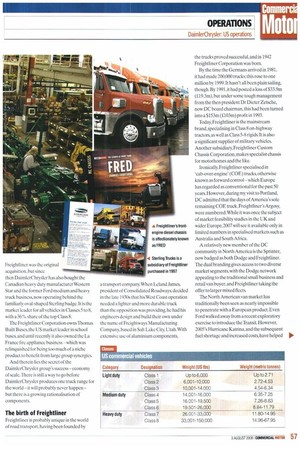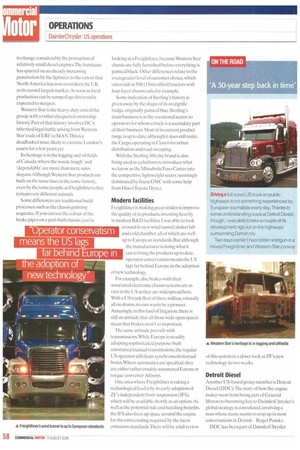STATES OF PLAY
Page 56

Page 57

Page 58

Page 59

If you've noticed an error in this article please click here to report it so we can fix it.
There's more to DaimlerChrysler than the faces of Mercedes-Benz and Mitsubishi Fuso that we see in Europe. A significant part of the operation now takes place in the United States — Colin Barnett visited two of its outposts.
DainilerChrysler didn't achieve its current position as the world's biggest manufacturer of commercial vehicles by playing in its own yard. It may not have begun the shift of the world truck industry to Europe, but at the start of the 1980s Daimler AG (as it then was) did make the first major breakthrough.
The transatlantic drift of the power base of truck-making really started with Volvo getting into bed with General Motors' truck business in 1979, but its inclination to take over the ailing Freightliner concern was foiled when Daimler pulled the rug from under Swedish feet in 1981. Volvo quickly recovered to buy the White business and Renault followed with Mack. Only Paccar has bucked the trend, buying into Europe in the shape of Daf.
Today, 25 years on from its arrival across the Atlantic and having evolved into DaimlerChrysler, the business that began with Karl Benz's dog cart has a serious North American CV portfolio.
The Chrysler merger brought in the Dodge and Jeep light CV brands, of course, but it's the heavier end that has the higher profile. Freightliner was the original acquisition, but since then DaimlerChrysler has also bought the Canadian heavy duty manufacturer Western Star and the former Ford medium and heavy truck business, now operating behind the familiarly oval-shaped Sterling badge. It is the market leader for all vehicles in Classes 5 to 8, with a 36% share of the top Class 8.
The Freightliner Corporation owns Thomas Built Buses, the US market leader in school buses, and until recently it also owned the La France lire appliance business—which was relinquished for being too much of a niche product to benefit from large group synergies.
And therein lies the secret of the DaimlerChrysler group's success— economy of scale. There is still a way to go before DaimlerChrysler produces one truck range for the world — it will probably never happen — but there is a growing rationalisation of components.
The birth of Freightliner
Freightliner is probably unique in the world of road transport, having been founded by a transport company. When Leland James, president of Consolidated Roadways, decided in the late 1930s that his West Coast operation needed a lighter and more durable truck than the opposition was providing, he had his engineers design and build their own under the name of Frcightways Manufacturing Company, based in Salt Lake City, Utah. With extensive use or aluminium components, the trucks proved successful, and in 1942 Freightliner Corporation was born.
By the time the Germans arrived in 1981, it had made 200,000 trucks; this rose to one million by 1999.11hasn't all been plain sailing, though. By 1991,4 had posted a loss of $33.9m (£19.3m), but under some tough management from the then president Dr Dieter Zetsche, now DC board chairman, this had been turned into a $153m (i103m) profit in 1993.
Today, Freightliner is the mainstream brand, specialising in Class 8 on-highway tractors, as well as Class 5-8 rigids. It is also a significant supplier of military vehicles. Another subsidiary, Freightliner Custom Chassis Corporation, makes specialist chassis for motorhomes and the like.
Ironically, Freightliner specialised in 'cab-over-engine' (COE) trucks, otherwise known as forward control— which Europe has regarded as conventional for the past 50 years. However, during my visit to Portland, DC admitted that the days of America's sole remaining COE truck,Freightliner's Argosy, were numbered.While it was once the subject of market feasibility studies in the UK and wider Europe, 2007 will see it available only in limited numbers in specialised markets such as Australia and South Africa.
A relatively new member of the DC community in North America is the Sprinter, now badged as both Dodge and Freightliner. The dual branding gives access to two diverse market segments, with the Dodge network appealing to the traditional small business and retail van buyer, and Freightliner taking the offer to larger mixed fleets.
The North American van market has traditionally been seen as nearly impossible to penetrate with a European product. Even Ford walked away from a recent exploratory exercise to introduce the Transit. However, 2005's Hurricane Katrina, and the subsequent fuel shortage and increased costs, have helped to change considerably the perception of relatively small diesel engines.The hurricane has spurred on an already increasing penetration by the Sprinter, to the extent that North America has now overtaken the UK as its second largest market. As soon as local production can be ramped up, this trend is expected to steepen.
Western Star is the heavy-duty arm of the group, with a rather chequered ownership history Part of that history involves DC's inherited legal battle arising from Western Star's sale of ERF to MAN.This is a deadlocked issue, likely to exercise London's courts for a few years yet.
Its heritage is in the logging and oil fields of Canada. where the words 'tough' and 'dependable' are more than mere sales slogans. Although Western Star products are built on the same lines in the same factory, even by the same people. as Freightliners. they remain very different animals.
Some differences are traditional build processes.such as the chassis painting sequence. If you can see the colour of the brake pipes on a part-built chassis, you're looking at a Freightliner, because Western Star chassis are fully furnished before everything is painted black. Other differences relate to the even greater level of customer choice. which can result in 50ft (15m) oilfield tractors with four-layer chassis rails, for example.
Some indication of Sterling's history is given away by the shape of its oval grille badge. originally painted blue. Sterling's main business is in the vocational sector, to operators for whom a truck is a secondary part of their business. Most of its current product range is up to date, although it does still make the Cargo, operating in Class 6 for urban distribution and road sweeping.
With the Sterling 360, the brand is also being used as a platform to introduce what we know as the Mitsubishi Fuso Canter into the competitive lightweight sector, seemingly dominated by IsuzudGMC with some help from Hino (Toyota Dyna).
Modern facilities
Freightliner is making great strides to improve the quality of its products, investing heavily in modern R&D facilities. I was able to look around its new wind tunnel, shaker lab and cold chamber, all of which are well up to European standards. But although the manufacturer is doing what it can to bring the products up to date, operator conservatism means the US lags far behind Europe in the adoption of new technology.
For example,disc brakes with their associated electronic chassis systems are as rare in the US as they are widespread here. With a US truck fleet of three million, virtually all on drums, no one wants be a pioneer. Amazingly, in this land of litigation, there is still an attitude that all those wide open spaces mean that brakes aren't so important.
The same attitude prevails with transmissions. While Europe is steadily adopting sophisticated purpose-built automated manual transmissions, the regular US operator still shuns synchromesh manual boxes.Where automatics are specified, they are either rather crudely automated Eatons or torque-converter Allisons.
One area where Freightliner is taking a technological lead is by its early adoption of ZF's independent front suspension (IFS), which will be available shortly as an option.As well as the potential ride and handling benefits. the IFS also frees up space around the engine for the extra cooling required by the latest emissions standards.There will be a full review of this system in a closer look at ZF's new technology in two weeks.
Detroit Diesel
Another US-based group member is Detroit Diesel (DDC).The story of how the engine maker went from being part of General Motors to becoming key to DaimlerChrysler's global strategy is convoluted,involving a man whose name seems to crop up in most conversations in Detroit — Roger Penske.
DDC has been part of DaimlerChrysler since 2000, and within Freightliner since 2004. Productivity at the Redmond, Michigan-based plant has doubled since 1998 with the same staff levels, a fact being repaid with a $300m (£163m) investment, a welcome commitment to the beleaguered Detroit metropolis.
We recently reported on its plans to play a large part in reducing DaimlerChrysler's current eight engines to just three (CM 8 June). Key to this plan is the new HDEP (heavy-duty engine platform) family, a quartet of straight-six engines ranging from 9.9 litres to 15.6 litres, producing from 248hp to 644hp, and up to 3.0(X)Nrn of torquellie 14.8-litre unit will first be seen in a Freightliner in about 12 months, with the other variants hitting the market over the next four years, and inevitably appearing in Mercedes-Benz products. EGR, SCR and compound turbocharging will all feature in the range.
In the meantime, a million Detroit 860 engines are on the road,with the EPA07 version ready for the market. While the traditional Detroit two-stroke engine is long gone from the civilian market, military demand. means it is still in limited production. is




























































































































































































